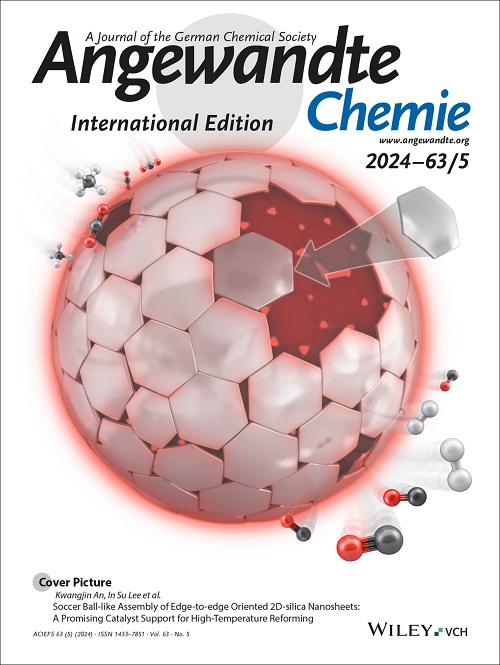Zincophilic Sites Enriched Hydrogen-bonded Organic Framework as Multifunctional Regulating Interfacial Layers for Stable Zinc Metal Batteries
IF 16.1
1区 化学
Q1 CHEMISTRY, MULTIDISCIPLINARY
引用次数: 0
Abstract
To construct an efficient regulating layer for Zn anodes that can simultaneously address the issues of dendritic growth and side reactions is highly demanded for stable zinc metal batteries (ZMBs). Herein, we fabricate a hydrogen-bonded organic framework (HOF) enriched with zincophilic sites as a multifunctional layer to regulate Zn anodes with controlled spatial ion flux and stable interfacial chemistry (MA-BTA@Zn). The framework with abundant H-bonds helps capture H2O and remove the solvated shells on [Zn(H2O)6]2+, leading to suppressed side reactions. The HOF layer also helps form electrolyte-philic surfaces and expose Zn (002) crystal planes which benefit for rapid conduction and uniform deposition of Zn2+, and weakened sides reactions. Additionally, the electrochemically active zincophilic sites (C=O, -NH2 and triazine groups) favor the targeted guidance and penetration of Zn2+ and provide advantageous sites for uniform Zn deposition. High Young’s modulus of the HOF layer further contributes to a high interfacial flexibility and stability against Zn plating-associated stress. The MA-BTA@Zn symmetric cells thereby obtain a substantially extended battery life over 1000 h at 4 mA cm-2. The MA-BTA@Zn||Cu half-cell demonstrates a highly reversible Zn stripping/plating process over 1500 cycles with impressive average Coulombic efficiency (CE) of 99.5% at 10 mA cm-2.富含亲锌位点的氢键有机框架作为稳定锌金属电池的多功能调节界面层
构建一种高效的锌阳极调节层,同时解决树枝状生长和副反应问题,是稳定的锌金属电池(ZMB)所亟需的。在此,我们制备了一种富含亲锌位点的氢键有机框架(HOF),作为一种多功能层,以可控的空间离子通量和稳定的界面化学性质调节锌阳极(MA-BTA@Zn)。具有丰富 H 键的框架有助于捕获 H2O 并去除 [Zn(H2O)6]2+ 上的溶解壳,从而抑制副反应。HOF 层还有助于形成亲电解质表面,暴露出 Zn (002) 晶面,从而有利于 Zn2+ 的快速传导和均匀沉积,并减弱副反应。此外,亲锌的电化学活性位点(C=O、-NH2 和三嗪基团)有利于 Zn2+ 的定向引导和渗透,并为 Zn 的均匀沉积提供了有利位点。HOF 层的高杨氏模量进一步增强了界面的柔韧性和稳定性,可抵御与 Zn 镀层相关的应力。因此,在 4 mA cm-2 电流条件下,MA-BTA@Zn 对称电池的电池寿命大大延长,超过 1000 小时。MA-BTA@Zn|||Cu 半电池在 1500 次循环中展示了高度可逆的锌剥离/电镀过程,在 10 mA cm-2 的条件下平均库仑效率 (CE) 达到 99.5%,令人印象深刻。
本文章由计算机程序翻译,如有差异,请以英文原文为准。
求助全文
约1分钟内获得全文
求助全文
来源期刊
CiteScore
26.60
自引率
6.60%
发文量
3549
审稿时长
1.5 months
期刊介绍:
Angewandte Chemie, a journal of the German Chemical Society (GDCh), maintains a leading position among scholarly journals in general chemistry with an impressive Impact Factor of 16.6 (2022 Journal Citation Reports, Clarivate, 2023). Published weekly in a reader-friendly format, it features new articles almost every day. Established in 1887, Angewandte Chemie is a prominent chemistry journal, offering a dynamic blend of Review-type articles, Highlights, Communications, and Research Articles on a weekly basis, making it unique in the field.
文献相关原料
| 公司名称 | 产品信息 | 采购帮参考价格 |
|---|

 求助内容:
求助内容: 应助结果提醒方式:
应助结果提醒方式:


